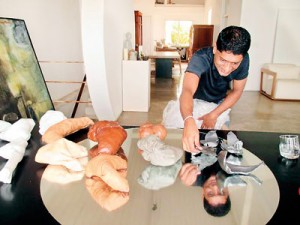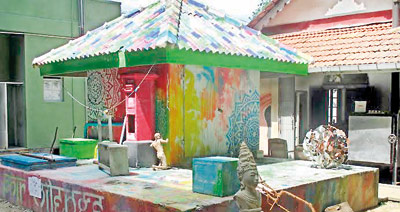Are Colombo’s budding artists pushing the envelope?
Situated diagonally across the road from one another, in the heart of Colombo 7 (one of the city’s most up-market postal codes) are two of the capital’s key artistic spaces – the University of Visual and Performing Arts (UVPA) and Saskia Fernando Gallery.

Creating meaning: Mahen Perera at work
In the latter, one gets to see regular, well-executed exhibitions by a select group of Sri Lanka’s leading artists and educators – such as Jagath Weerasinghe and Chandragupta Thenuwara – in a commercial setting.
Whereas in the former, one can observe sporadic, early experiments of artistic form and concept by a whole host of students in one of the city’s main independent art schools.
Separating and connecting these two opposing institutions is a simple zebra crossing, where everyone from gallery-goers and scholars, professionals and pupils, the seasoned and the hopeful traverse.
It is this, in-between, abstract space that intrigues the most, as it still feels relatively unknown and somewhat precarious. The apparent gap between the older and younger generations of artists in Sri Lanka’s capital makes one wonder: Where do the post-graduate, emerging or mid-career artists practise in Colombo?
How are they engaging or responding to the city’s socio-political, ecological and psychological climate? What are they interested in or influenced by? Most importantly, why aren’t their voices more audible in the city?
Speaking to 30-year-old Prashan Danushka Marasinghe, who graduated from UVPA a year ago and practises as one of Colombo’s only video artists, provides some insight.
“I used to love painting. Then at university, I found that I was not developing. I lost my sense. I started watching films, hanging out with filmmakers and making short films.
I found I was getting more knowledge from outside of campus.” Marasinghe started to spend time at the not-for-profit Theertha International Artists Association, where he met a multitude of international artists, read extensively in the library and considered how to use photography and video as tools in his work.
“Okay, I suddenly thought. This is art, I can do this.”
In 2011, while still a student, Marasinghe exhibited his first video installations in a group exhibition at the Goethe Institut alongside the newly-formed COCA collective; a year later he held his first solo exhibition at Theertha’s Red Dot Gallery.
His work often explores contemporary social structures and the residual consequences of the conflict, which stems from his formative experiences – such as feeling marginalized and under increasing surveillance – as a student in post-war Colombo.
“Tour on a Hospital Bed” (2012) for example, takes the viewer on a horizontal sojourn around Independence Square’s walkways, through the obscured perspective of hospital bed rails, and offers an alternative take on the previous government’s creation of purportedly ‘beautiful’ public spaces.
Though works like these are relatively inexpensive to make, Marasinghe admits that exhibiting them – including at the recent arts festival Cinnamon Colomboscope – requires a lot of funding due to the hiring and maintenance of digital display equipment.
In a bid to support more work like this, the artist is working on a proposal for a “Video Platform” to be staged next year at Theertha, where he currently works to support himself.
When asked about the financial constraints of being a video artist in Colombo, Marasinghe replies that, to date, he has not sold a single work.
This doesn’t seem to bother him though, he says, “Focusing on selling becomes a headache.”
In contrast to this, selling his work, showcasing his portfolio and creating a brand for himself, is of paramount importance to Colombo-based artist Kavan Balasuriya.
Having graduated from London’s Central Saint Martins in 2014, 23- year-old Balasuriya came back to Colombo with the ambition of exhibiting his work at a local gallery.
When galleries turned him down, supposedly saying that to exhibit such a young artist would be a risk, Balasuriya decided to take matters into his own hands.
“Having no gallery representation gives me total control over what I show – and maybe I’m willing to make certain kinds of mistakes.”
Balasuriya landed a position at advertising agency Ruby Studio, where he works as a graphic design intern and gallery coordinator.
It was on the top floor of the agency, temporarily converted into a gallery space, that Balasuriya held his first solo show in April entitled, “Exhibition One,” followed by a second exhibition in October called “Exhibition Two.”
The shows in themselves largely consisted of Balasuriya’s drawings from university –formal, monochromatic, abstract compositions on paper – and sold well.
“Exhibitions are ultimately about the salability of the work. I want to have commercial grounding before I start making more critical work.”
When asked why he doesn’t feel the need to engage more critically with the city’s current, transformative moment – which has seen significant cultural, social and economic change since the new administration took over nearly a year ago – he replies, “During the war, you couldn’t make work that didn’t reflect on it. It would have been selfish. But now the war is over. Art and design is going places.”
Balasuriya is also part of a new artists’ group called The Hot Butter Collective (a take on the popular local dish, hot butter cuttlefish) and took part in their debut exhibition at Barefoot Gallery in May.
The experimental show was made up of a variety of installations of a fairly frivolous and extrinsic nature. In a bid to explain this approach, Balasuriya says, “Many of these ideas were generated outside of the country.
Half of the people in the collective went to college abroad. Perhaps that’s why they’re not reflective of the here and now.”
On the other scale of the spectrum, is a mid-career artist who also studied abroad and returned to Colombo a few years ago, Mahen Perera.
During his time at the Lasalle College of Arts in Singapore nearly a decade ago, Perera describes how he was interested in painting, but his lecturers pushed him to think and question beyond this.
“What do you want to explore about yourself or the collective aspect of things?” they apparently said. “Why do you really want to paint?”
Around this time Perera started to wash his canvases, moving away from more visual notions of art, to the physicality of the work.
Perera explains that by repeatedly rinsing his paintings, a process he still uses, he sees the poetry and potential of the work. There seems to be a cathartic, aggressive element to the practice, as well as a poignant, intimate one. “It’s about excavating rather than building up,” he explains.

‘Colombo is fairly well-positioned to cultivate and foster its next generation of artists’
After his time in Singapore, Perera took part in an artist residency in Prague, where he met several renowned international artists, including Rirkrit Tiravanija, with whom he would talk about the simultaneous simplicity and weight of art.
It is this idea of conversation and engagement that continues to drive Perera here in Colombo. On his return to his home city, Perera began to incorporate found objects in his work, which he would sometimes sculpt, sow or mould to create something new.
It was the raw narrative and concept of residue – which seemed to be omnipresent in developing Colombo – that inspired him. “My work is about creating a balance between spontaneity and precision; the mysterious juxtapositions.
I’m not interested in creating meaning. I’m more interested in the human condition rather than larger politics.”
Perera currently works as a full-time artist and is exhibiting his artwork at Hempel Galleries this month. When asked about the current moment for art in Colombo, Perera is fairly positive.
“Everything was fragmented before. Now curators are coming, it’s giving us recognition and interest is starting to grow – now we need to grow!”
The need to grow and flourish, takes us back to full-circle to the ideas and opportunities that emerging and mid-career artists are exposed to in Colombo.
Back at the university, Priyantha Udagedara – an alumnus of UVPA, who did his Masters and PhD at Leeds Metropolitan University (U.K.) and has now returned to teach here – talks about the challenges and prospects for young artists.
“We constantly urge our artists to research and look at outside sources. Many of them don’t want to learn beyond the 1980s art movements, as they deem the English too complicated.”
In an attempt to try and address this critical thinking void, Udagedara and Thenuwara recently published a textbook in Sinhala covering significant art historical movements and contemporary theorists – from Michel Foucault to Jacques Lacan.
Through their work at the Art History Department in the university, the lecturers hope to generate a new wave of critics, curators and art historians who reflect upon the local scene more regularly.
Weerasinghe agrees that the development of critique and self-reflection is key to the development of art in the country. “The main problem with the Sri Lankan art scene is that artists are not willing to be self-critical.”
In a bid to rectify this, Weerasinghe himself is proposing to encourage and nurture critique in his proposed expansion for Theertha, which will be a space that incorporates a comprehensive library, regular talks, programmes and educational initiatives in collaboration with government schools.
However, this still doesn’t address the overarching issue of artists being tempted to capitalize on Colombo’s exponential growth.
“Tourism is booming, graduates are more likely to get interior design jobs, sell their work on the road-side, go into advertising or teach,” says Udagedara.
It seems that emerging and mid-career artists in Colombo are at a possible tipping point. Six years after the conflict and a year into the new socio-political condition, the city is fairly well-positioned to cultivate and foster its next generation of artists.
Nevertheless, only through healthy and regular critique, a greater variety of creative platforms and increased opportunities for post-educational mentoring, will we be able to hear more of Colombo’s poised and promising artistic voices break through – and begin to amplify.


